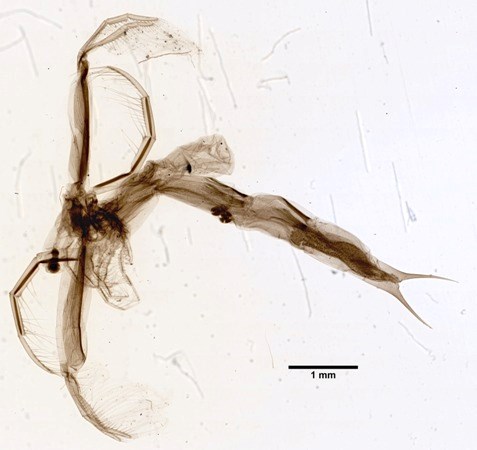Dr. Britt Hall, a biology professor in the Faculty of Science at the University of Regina, has led a study that helps to answer a decades-old question – why do fish in southern Saskatchewan’s Katepwa Lake contain such high levels of methylmercury?
After years of research and around-the-clock water sampling, Hall’s study found that the high levels of methylmercury are ultimately caused by large water fleas called Leptodora, or 'ghost fleas.'
Hall, whose research focuses on how mercury moves in the environment, worked with data that Dr. Peter Leavitt,a professor of limnology at the U of R, began collecting 23 years ago. The pair, along with other U of R researchers, published their findings in a recent paper “Mercury Elevator in Lakes: A Novel Vector of Methylmercury Transfer to Fish via Migratory Invertebrates” in Environmental Science & Technology Letters of the American Chemical Society.
“Prairie lakes, such as Katepwa, are productive – meaning they contain lots of nutrients that allow algae to grow, typically diluting the methylmercury and resulting in a lower level in fish,” explains Hall. “But in Katepwa Lake, the data was showing that methylmercury concentrations are actually quite high and we didn’t know why that was.”
Hall’s study found that the Leptodora, a large water flea, migrates up from the mercury-rich sediments at the bottom of the lake at night to feed near the surface of the water, transferring the methylmercury to fish when they are eaten. They carry mercury in a way that is similar to an elevator carrying people from ground level to their offices or apartments on upper floors. This feeding boosts the amount of toxin in the fish, which are in turn eaten by larger and larger fish, resulting in a bioaccumulation of mercury when humans consume the fish.
“Leptodora are very interesting creatures,” explains Hall. “They’re big for water fleas, about 1.7 centimetres long and almost completely clear. They developed a lack of coloration as a prey-avoidance mechanism, because if they’re clear, it’s difficult for their hunters to see them.”
Dr. Leavitt has coined the term “ghost fleas” to describe these almost transparent creatures and to differentiate them from the many different varieties of water fleas. When he began to study the methylmercury levels in Katepwa Lake, one question remained unanswered – how do fish hunt these ghost fleas at night if they are so transparent?
Dr. Richard Vogt, a former post-doctoral student at the University of Regina, conducted an experiment that determined the fish in Katepwa Lake have a way of hunting without being able to see their prey. The fish can sense the pressure waves the Leptodora make as they swim through the water, which allows the fish to target them at night. This was the missing piece of information that researchers didn’t have.
Hall is now working with two graduate students, with their research focusing on Saskatchewan wetland ponds and how they are affected by climate change. They are looking at how carbon influences methylmercury production and identifying the bacterial communities in wetlands to determine what sort of organisms are there that are transforming mercury to methylmercury.
“Our wetlands are so responsive to climate change, what I want to know is how factors such as temperature and precipitation impact methylmercury production in wetlands,” explains Hall.
University of Regina scientists are continuing their long-term studies of the Qu’Appelle lakes. Now in its 27th year, the Qu’Appelle Valley Long-Term Ecological Research program is one of the longest-running lake programs in Canada. Funding for the program is provided by the Natural Sciences and Engineering Research Council of Canada, Canada Research Chair program, and Canada Foundation for Innovation.
“The research that has been done in the Qu’Appelle lakes, especially Katepwa Lake, is an ongoing project that we are very proud of here at the University,” says Dr. Kathleen McNutt, vice-president (research). “This research could be helpful in determining why fish in other lakes around the country, and even the world, have higher-than-normal levels of methylmercury.”



